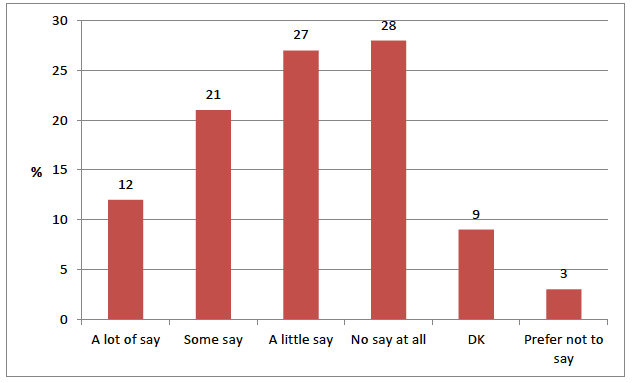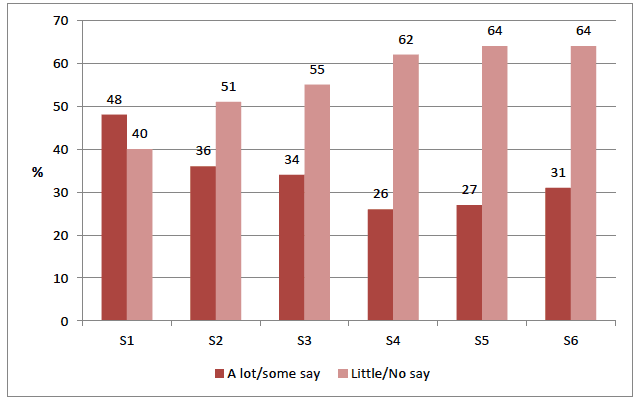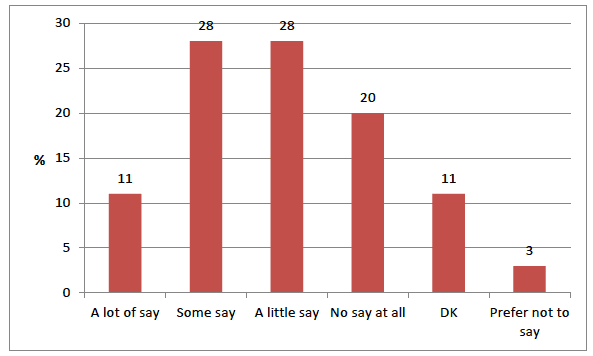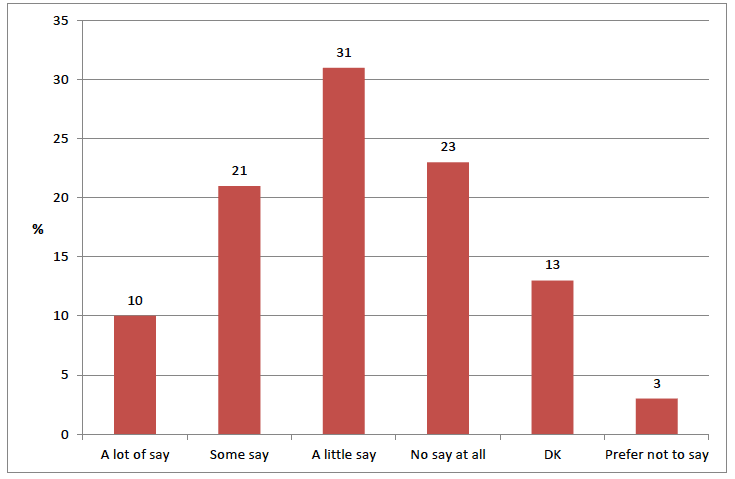Young people's participation in decision making in Scotland: attitudes and perceptions
Findings from a survey of secondary school pupils on perception of their ability to influence decisions that affect them.
4. Views on decision making in schools
The survey also included a number of questions on how much say pupils have in the running of their school. Wording is slightly different as these questions were commissioned as part of a separate question set, but they complement the questions about out of school activities.
Pupils were asked how much say they have over:
- What they learn
- How they learn, defined as 'which teaching and learning methods are used or which activities they do'
- Decisions which affect the school as a whole
What they learn
As Figure 4.1 shows, a third of students said that they had either 'a lot' (12 per cent) or 'some '(21 per cent) say in what they learn. Over half (55 per cent) said they had 'little' (27 per cent) or 'no' (28 per cent) say in what they learn.
Figure 4.1 How much say young people have on what they
learn

Base: 1781
Girls were more negative than boys, with 60 per cent saying that they had little or no say over what they learn, compared to 51 per cent of boys.
As Figure 4.2 shows, the percentage saying they had little or no say increased consistently with school year, from 40 per cent in S1, to 64 per cent in S6. The percentage saying they have a lot or of say decreased in line with this.
Figure 4.2 How much say young people have on what they
learn, by school year

Base: 1755
There was no consistent pattern by area deprivation.
How they learn
When asked about how they learn, just under four in ten young people felt that they had 'a lot' (11 per cent) or 'some' (28 per cent) say in how they learn. Just under half said that they had 'little' (28 per cent) or 'no' (20 per cent) say in how they learn. Figure 4.3 illustrates.
Figure 4.3 How much say young people have on how they
learn

Base: 1781
Those in S1 were more positive than other school years. There were no other meaningful socio-demographic differences in findings.
Decisions affecting the whole school
Finally, survey respondents were asked how much say they had over decisions that affected the whole school. Just under a third of students said that they had either 'a lot' (10 per cent) or 'some' (21 per cent) say over decisions that affect their school as a whole. Over half said they had 'little' (31 per cent) or 'no' (23 per cent) say over decisions that affect their school as a whole. Figure 4.4 illustrates.
Figure 4.4 How much say young people have on decisions
affecting the school as a whole

Base: 1781
S1 pupils were more positive than other school years. There were no other meaningful socio-demographic differences in findings.
How to access background or source data
The data collected for this social research publication:
☐ are available in more detail through Scottish Neighbourhood Statistics
☐ are available via an alternative route
☒ may be made available on request, subject to consideration of legal and ethical factors. Please contact socialresearch@scotland.gsi.gov.uk for further information.
☐ cannot be made available by Scottish Government for further analysis as Scottish Government is not the data controller.
Contact
There is a problem
Thanks for your feedback